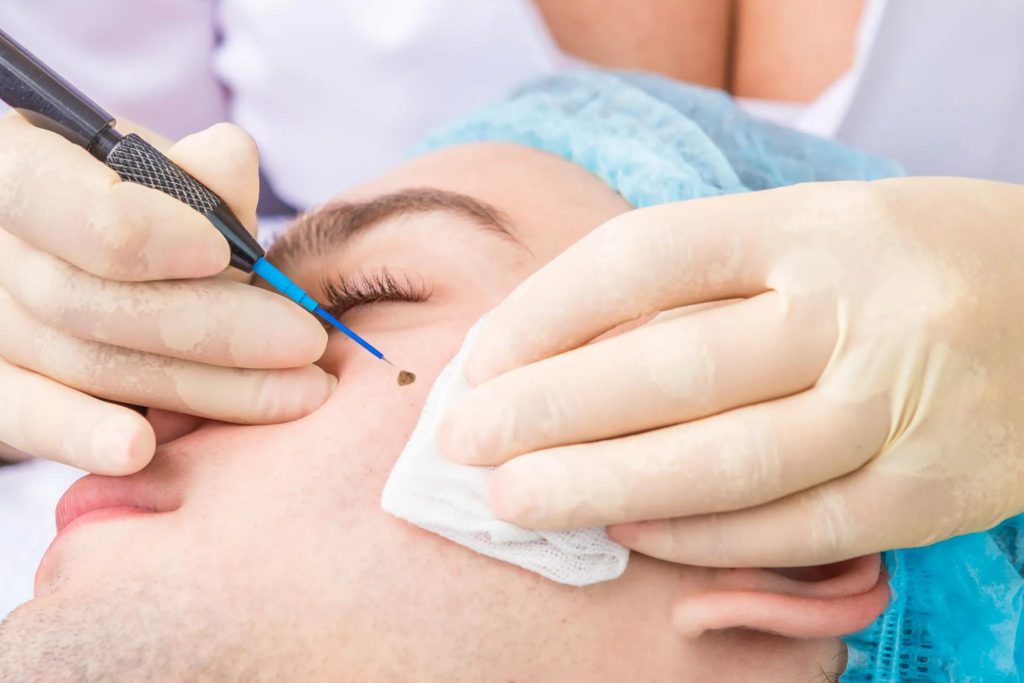Moles are common skin growths that often appear during childhood or early adulthood. While many are harmless, some can be a source of concern—particularly when located on the face. Whether for cosmetic improvement or health-related worries, mole removal on face is a widely discussed and increasingly popular procedure. But before booking a consultation or trying home remedies, it’s essential to understand the types of moles, available treatment options, and potential risks.
In this guide, we’ll explore how to identify suspicious moles, the safest removal methods, and how to minimise scarring. If you’ve ever wondered how to get rid of moles, whether laser treatment for moles works, or how to avoid scars from removing moles, this article offers expert-backed insights to help you decide.
What Are Facial Moles and Why Do We Get Them?
Facial moles are pigmented skin growths that form when clusters of melanocytes (melanin-producing cells) gather beneath the skin. These growths can vary in shape, size, and colour—from flat to raised and light brown to almost black.
Why do moles commonly appear on the face? Genetics, sun exposure, and hormonal changes all play a role. Moles may appear during puberty, pregnancy, or as a result of certain medications. Since the face is regularly exposed to sunlight, UV damage often triggers the formation of new moles.
Most facial moles are harmless. However, if a mole on face grows, changes colour, or develops irregular borders, it’s important to consult a professional. Understanding their cause can help you decide if mole removal is appropriate.
Do Moles Get Bigger with Age?
Yes, some moles can grow larger as you age. This is often due to hormonal fluctuations, sun exposure, or genetic predisposition. Puberty and pregnancy are common periods when moles may darken or expand.
That said, not every growing mole is dangerous. Benign moles may gradually increase in size. However, any sudden or significant change—especially in shape, colour, or texture—should be checked by a dermatologist. Monitoring your skin ensures you can detect early warning signs and seek timely mole removal, if needed.
Is It OK to Remove a Mole from Your Face?
Yes—mole removal on face is generally safe when performed by a licensed medical professional. Many choose removal for aesthetic reasons, particularly when moles are large, raised, or in a prominent position. Others opt for removal due to discomfort or concerns about possible skin cancer.
Before removing the mole, your clinician will examine it to confirm whether it’s benign. If necessary, a sample may be sent for testing. Most removing of moles procedures in a clinic are quick and with minimal risk.
Home removal methods should be avoided. DIY techniques may cause infection, scarring, or incomplete removal. Clinics offer safer solutions like laser mole removal or minor surgical procedures—both designed to ensure hygiene and reduce scarring.
How to Tell If a Mole Is Cancerous or Harmless
Most moles are harmless, but it’s important to recognise the signs of a potentially cancerous one. Dermatologists use the ABCDE rule to assess suspicious moles:
- Asymmetry – One half doesn’t match the other
- Border – Irregular, blurred, or jagged edges
- Colour – Uneven tones or multiple colours
- Diameter – Larger than 6mm
- Evolving – Changes in size, shape, or sensation
If a mole exhibits any of these features, seek medical advice promptly. Subtle signs may be visible only with dermoscopic tools. Early detection supports safer outcomes and improves treatment success.
Should You Be Concerned If a Mole Is Getting Bigger?
A growing mole is not always a sign of trouble, but it does deserve attention. If the increase in size is accompanied by itching, bleeding, or irregular borders, consult a specialist. These symptoms may suggest melanoma or another skin condition.
Self-checks using the ABCDE method can help you detect changes early. Even a mole that appears benign should be examined if it’s on the face, especially if you’re considering mole removal. A dermatologist can assess whether removal is necessary for health or cosmetic reasons.

How Is Mole Removal Done in a Clinic Setting?
Professional mole removal on face is straightforward and tailored to the mole’s type and depth. Common clinical methods include:
- Surgical Excision: The mole is cut out with a scalpel, often followed by stitches. It’s ideal for suspicious or deep moles and allows for lab testing.
- Shave Excision: The mole is shaved flush with the skin—no stitches needed. Healing is quick but may leave minor marks.
- Laser Mole Removal: A non-invasive option using laser light to break down mole pigment, perfect for flat, pigmented moles with minimal recovery time.
All procedures are typically carried out under local anaesthetic. Your clinician will recommend the best method based on the mole’s location, size, and characteristics.
Is There a Downside to Removing Moles?
Although safe, mole removal on face carries some minor risks. The most common concern is scars from removing moles. Scarring depends on the mole’s depth, removal method, and your skin’s natural healing ability.
Other possible side effects include:
- Infection, if the area isn’t properly cared for
- Pigmentation changes, such as dark or light patches
- Regrowth, if the mole isn’t completely removed
Some moles may need biopsy instead of immediate removal. Choosing a reputable clinic and following aftercare instructions help reduce the likelihood of complications.
Will the Mole Grow Back After Removal?
Yes, moles can grow back in some cases. This typically happens when the removal method doesn’t reach deep enough to remove all pigment cells—more likely with shave excision or laser mole removal.
Surgical excision, on the other hand, removes both surface and deeper tissue, lowering the risk of regrowth. If a mole reappears, monitor it closely for changes and consult your doctor if needed.
Choosing a skilled practitioner for mole removal on face helps prevent recurrence and ensures a cleaner, longer-lasting result.
Do Moles Have Roots Under the Skin?
Moles don’t have “roots” in the traditional sense—unlike plants—but they can extend into the deeper layers of the skin. What people often refer to as “roots” are actually clusters of melanocytes (pigment-producing cells) that may lie beneath the visible surface. These cells are responsible for the colour and structure of the mole, and when they penetrate below the upper skin layers, removing the mole completely becomes more complex.
This deeper placement is why certain superficial treatments, such as shave excision or laser mole removal, may not fully eliminate all the pigment cells. If even a small portion remains, there’s a chance the mole could reappear over time. This is more common with raised or pigmented moles that are partially embedded in the dermis.
Understanding how far a mole extends beneath the skin is crucial when selecting the most effective removal method. For moles that are flat but deeply rooted or those showing signs of regrowth, surgical excision is often the most thorough and reliable option. It allows for complete removal of both surface and sub-surface cells, reducing the risk of recurrence and offering greater peace of mind—particularly for facial moles where cosmetic outcomes are a priority.
Why Home Mole Removal Is Risky
While convenient, DIY removing of moles is never recommended. Methods like scraping, acids, or garlic can cause burns, infections, or even permanent scarring.
Worse still, a mole that appears harmless may actually be cancerous. Removing it at home delays proper diagnosis and treatment.
Common risks include:
- Infection from unclean tools
- Severe scarring
- Incomplete removal, causing regrowth
- Bleeding or tissue damage
Professional laser treatment for moles or surgical options are safer, cleaner, and more precise.
How to Prevent or Minimise Scarring After Mole Removal
Although scarring is part of the healing process, you can minimise its appearance, especially after mole removal on face.
Follow these aftercare tips:
- Clean the area as instructed
- Avoid picking scabs
- Use silicone-based scar gels or sheets
- Apply SPF daily after the wound has healed
- Keep the skin moisturised
Some individuals—particularly those with darker skin or a history of keloids—may scar more easily. In such cases, your doctor may recommend tailored aftercare solutions.
When Should You See a Doctor About a Mole on Your Face?
Most moles are harmless, but certain changes demand medical attention, especially on the face. Consult a doctor if you notice:
- Rapid growth
- Colour variation
- Jagged or irregular borders
- Bleeding, crusting, or itching
- A new mole appearing in adulthood
Even non-suspicious moles that cause irritation or affect your confidence are valid reasons to seek help. Routine checks are important if you have a family history of skin cancer or multiple moles.
Taking the Right Steps Toward Safe Mole Removal on Face
Whether for cosmetic reasons or peace of mind, mole removal on face is a safe and effective option when carried out by qualified professionals. Understanding your moles, recognising warning signs, and choosing the right removal method are all key to ensuring healthy skin and avoiding unnecessary risks.
From laser mole removal to surgical options, today’s treatments are designed to be minimally invasive while delivering excellent cosmetic results. While DIY solutions may promise quick fixes, they often come with hidden dangers, such as infection, scarring, or incomplete removal. Always consult a trusted expert before making any decisions about your skin.
If you’re ready to explore your options, the team at Northern Beaches Cosmetic offers professional consultations and expert care tailored to your needs. Whether you’re concerned about a mole on face or simply want clearer skin, their personalised approach ensures safety, precision, and natural-looking results.

